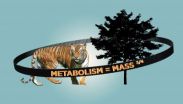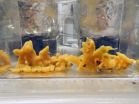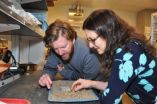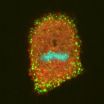(Press-News.org) Why does a mouse's heart beat about the same number of times in its lifetime as an elephant's, although the mouse lives about a year, while an elephant sees 70 winters come and go? Why do small plants and animals mature faster than large ones? Why has nature chosen such radically different forms as the loose-limbed beauty of a flowering tree and the fearful symmetry of a tiger?
These questions have puzzled life scientists since ancient times. Now an interdisciplinary team of researchers from the University of Maryland and the University of Padua in Italy propose a thought-provoking answer based on a famous mathematical formula that has been accepted as true for generations, but never fully understood. In a paper published the week of Feb. 17, 2014 in the Proceedings of the National Academy of Sciences, the team offers a re-thinking of the formula known as Kleiber's Law. Seeing this formula as a mathematical expression of an evolutionary fact, the team suggests that plants' and animals' widely different forms evolved in parallel, as ideal ways to solve the problem of how to use energy efficiently.
If you studied biology in high school or college, odds are you memorized Kleiber's Law: metabolism equals mass to the three-quarter power. This formula, one of the few widely held tenets in biology, shows that as living things get larger, their metabolisms and their life spans increase at predictable rates. Named after the Swiss biologist Max Kleiber who formulated it in the 1930s, the law fits observations on everything from animals' energy intake to the number of young they bear. It's used to calculate the correct human dosage of a medicine tested on mice, among many other things.
But why does Kleiber's Law hold true? Generations of scientists have hunted unsuccessfully for a simple, convincing explanation. In this new paper, the researchers propose that the shapes of both plants and animals evolved in response to the same mathematical and physical principles. By working through the logic underlying Kleiber's mathematical formula, and applying it separately to the geometry of plants and animals, the team was able to explain decades worth of real-world observations.
"Plant and animal geometries have evolved more or less in parallel," said UMD botanist Todd Cooke. "The earliest plants and animals had simple and quite different bodies, but natural selection has acted on the two groups so the geometries of modern trees and animals are, remarkably, displaying equivalent energy efficiencies. They are both equally fit. And that is what Kleiber's Law is showing us."
Picture two organisms: a tree and a tiger. In evolutionary terms, the tree has the easier task: convert sunlight to energy and move it within a body that more or less stays put. To make that task as efficient as possible, the tree has evolved a branching shape with many surfaces – its leaves.
"The tree's surface area and the volume of space it occupies are nearly the same," said physicist Jayanth Banavarr, dean of the UMD College of Computer, Mathematical, and Natural Sciences. "The tree's nutrients flow at a constant speed, regardless of its size."
With these variables, the team calculated the relationship between the mass of different tree species and their metabolisms, and found that the relationship conformed to Kleiber's Law.
To nourish its mass, an animal needs fuel. Burning that fuel generates heat. The animal has to find a way to get rid of excess body heat. The obvious way is surface cooling. But because the tiger's surface area is proportionally smaller than its mass, the surface is not up to the task. The creature's hide would get blazing hot, and its coat might burst into flames.
So as animals get larger in size, their metabolism must increase at a slower rate than their volume, or they would not be able to get rid of the excess heat. If the surface area were the only thing that mattered, an animal's metabolism would increase as its size increased, at the rate of its mass to the two-thirds power. But Kleiber's Law, backed by many sets of observations, says the actual rate is mass to the three-quarters power.
Clearly there's a missing factor, and scientists have pored over the data in an attempt to find out what it is. Some have proposed that the missing part of the equation has to do with the space occupied by internal organs. Others have focused on the fractal, or branching, form that is common to tree limbs and animals' blood vessels, but added in new assumptions about the volume of fluids contained in those fractal networks.
The UMD and University of Padua researchers argue a crucial variable has been overlooked: the speed at which nutrients are carried throughout the animals' bodies and heat is carried away. So the team members calculated the rate at which animals' hearts pump blood and found that the velocity of blood flow was equal to the animals' mass to the one-twelfth power.
"The information was there all along, but its significance had been overlooked," said hydrologist Andrea Rinaldo of Italy's University of Padua and Switzerland's Ecole Polytechnique Federale. "Animals need to adjust the flow of nutrients and heat as their mass changes to maintain the greatest possible energy efficiency. That is why animals need a pump – a heart – and trees do not."
Plugging that information into their equation, the researchers found they had attained a complete explanation for Kleiber's Law.
"An elegant answer sometimes is the right one, and there's an elegance to this in the sense that it uses very simple geometric arguments," said physicist Amos Maritan of the University of Padua. "It doesn't call for any specialized structures. It has very few preconditions. You have these two lineages, plants and animals, that are very different and they arrive at the same conclusion. That is what's called convergent evolution, and the stunning result is that it's being driven by the underlying physics and the underlying math."
INFORMATION:
UMDCP/CMNS
Media contact:
Abby Robinson
abbyr@umd.edu
301-405-5845
How evolution shapes the geometries of life
University of Maryland physicist and colleagues solve a longstanding biological puzzle
2014-02-18
ELSE PRESS RELEASES FROM THIS DATE:
Theory on origin of animals challenged: Animals needs only extremely little oxygen
2014-02-18
One of science's strongest dogmas is that complex life on Earth could only evolve when oxygen levels in the atmosphere rose to close to modern levels. But now studies of a small sea sponge fished out of a Danish fjord shows that complex life does not need high levels of oxygen in order to live and grow.
The origin of complex life is one of science's greatest mysteries. How could the first small primitive cells evolve into the diversity of advanced life forms that exists on Earth today? The explanation in all textbooks is: Oxygen. Complex life evolved because the atmospheric ...
Researchers warn against abrupt stop to geoengineering method
2014-02-18
As a range of climate change mitigation scenarios are discussed, University of Washington researchers have found that the injection of sulfate particles into the atmosphere to reflect sunlight and curb the effects of global warming could pose a severe threat if not maintained indefinitely and supported by strict reductions in greenhouse gas (GHG) emissions.
The new study, published today, 18 February, in IOP Publishing's journal Environmental Research Letters, has highlighted the risks of large and spatially expansive temperature increases if solar radiation management ...
First biological marker for major depression could enable better diagnosis and treatment
2014-02-18
Teenage boys who show a combination of depressive symptoms and elevated levels of the 'stress hormone' cortisol are up to fourteen times more likely to develop major depression than those who show neither trait, according to research funded by the Wellcome Trust.
In a study published today in the Proceedings of the National Academy of Sciences, researchers from the University of Cambridge have identified the first biomarker – a biological signpost – for major, or clinical, depression. They argue that this could help identify those boys in particular at greatest risk ...
Why tackling appetite could hold the key to preventing childhood obesity
2014-02-18
A heartier appetite is linked to more rapid infant growth and to genetic predisposition to obesity, according to two papers published in JAMA Pediatrics today (Monday).
The studies investigated how weight gain is linked to two key aspects of appetite, namely lower satiety responsiveness (a reduced urge to eat in response to internal 'fullness' signals) and higher food responsiveness (an increased urge to eat in response to the sight or smell of nice food).
The first paper reveals that infants with a heartier appetite grew more rapidly up to age 15 months, potentially ...
Ancient herring catch nets fisheries weakness
2014-02-18
Archaeological data indicate modern herring management needs to take a longer look into the past to manage fisheries for the future says a new study involving Simon Fraser University researchers.
That is one of the key findings in the study, just published online in Proceedings of the National Academy of Sciences (PNAS). SFU researchers Iain McKechnie, Dana Lepofsky and Ken Lertzman, and scientists in Ontario, Alberta and the United States are its co-authors.
The study is one of many initiatives of the SFU-based Herring School, a group of researchers that investigates ...
'It takes a village' -- Community-based methods for improving maternal and newborn health
2014-02-18
A series of studies are published in a special supplement that presents results of the Maternal and Newborn Health in Ethiopia Partnership—a three-year pilot program funded by the Bill & Melinda Gates Foundation with the goal of improving the health of Ethiopian mothers and their newborns. This special issue of the Journal of Midwifery & Women's Health is published by Wiley on behalf of the American College of Nurse-Midwives.
High mortality rates for pregnant women and newborns continue to be a major health concern in Africa, with Ethiopia being one of the most affected ...
Mitosis mystery solved as role of key protein is confirmed
2014-02-18
Researchers from Warwick Medical School have discovered the key role of a protein in shutting down endocytosis during mitosis, answering a question that has evaded scientists for half a century.
The study, published today in the journal eLife, is the first to outline the role of actin, a protein, in shutting down clathrin-dependent endocytosis during mitosis.
Endocytosis is the process by which cells absorb molecules that are too large to pass through the plasma membrane, such as proteins. Clathrin-dependent endocytosis is the most common route for this. Clathrin, a ...
Learning to see better in life and baseball
2014-02-17
With a little practice on a computer or iPad—25 minutes a day, 4 days a week, for 2 months—our brains can learn to see better, according to a study of University of California, Riverside baseball players reported in the Cell Press journal Current Biology on February 17. The new evidence also shows that a visual training program can sometimes make the difference between winning and losing.
The study is the first, as far as the researchers know, to show that perceptual learning can produce improvements in vision in normally seeing individuals.
"The demonstration that ...
Outsmarting nature during disasters
2014-02-17
The dramatic images of natural disasters in recent years, including hurricanes Katrina and Sandy and the Tohoku, Japan, earthquake and tsunami, show that nature, not the people preparing for hazards, often wins the high-stakes game of chance.
"We're playing a high-stakes game against nature without thinking about what we're doing," geophysicist Seth Stein of Northwestern University said. "We're mostly winging it instead of carefully thinking through the costs and benefits of different strategies. Sometimes we overprepare, and sometimes we underprepare."
Stein will ...
Zoonotic diseases and global viral pandemics
2014-02-17
Emergence of new microbes
While many endemic infectious diseases of humans have been largely contained, new microbes continue to emerge to threaten human and animal health. Such emerging infectious diseases are not confined to humans and their livestock but extend to wildlife ecosystems; the finely-tuned dynamic balance of which is destabilised by human interventions. The changes in the scale and manner of livestock production and marketing, the increase of global travel and trade including the trade in domestic livestock as well as the pet animal trade, the increasing ...
LAST 30 PRESS RELEASES:
Making lighter work of calculating fluid and heat flow
Normalizing blood sugar can halve heart attack risk
Lowering blood sugar cuts heart attack risk in people with prediabetes
Study links genetic variants to risk of blinding eye disease in premature infants
Non-opioid ‘pain sponge’ therapy halts cartilage degeneration and relieves chronic pain
AI can pick up cultural values by mimicking how kids learn
China’s ecological redlines offer fast track to 30 x 30 global conservation goal
Invisible indoor threats: emerging household contaminants and their growing risks to human health
Adding antibody treatment to chemo boosts outcomes for children with rare cancer
Germline pathogenic variants among women without a history of breast cancer
Tanning beds triple melanoma risk, potentially causing broad DNA damage
Unique bond identified as key to viral infection speed
Indoor tanning makes youthful skin much older on a genetic level
Mouse model sheds new light on the causes and potential solutions to human GI problems linked to muscular dystrophy
The Journal of Nuclear Medicine ahead-of-print tip sheet: December 12, 2025
Smarter tools for peering into the microscopic world
Applications open for funding to conduct research in the Kinsey Institute archives
Global measure underestimates the severity of food insecurity
Child survivors of critical illness are missing out on timely follow up care
Risk-based vs annual breast cancer screening / the WISDOM randomized clinical trial
University of Toronto launches Electric Vehicle Innovation Ontario to accelerate advanced EV technologies and build Canada’s innovation advantage
Early relapse predicts poor outcomes in aggressive blood cancer
American College of Lifestyle Medicine applauds two CMS models aligned with lifestyle medicine practice and reimbursement
Clinical trial finds cannabis use not a barrier to quitting nicotine vaping
Supplemental nutrition assistance program policies and food insecurity
Switching immune cells to “night mode” could limit damage after a heart attack, study suggests
URI-based Global RIghts Project report spotlights continued troubling trends in worldwide inhumane treatment
Neutrophils are less aggressive at night, explaining why nighttime heart attacks cause less damage than daytime events
Menopausal hormone therapy may not pose breast cancer risk for women with BRCA mutations
Mobile health tool may improve quality of life for adolescent and young adult breast cancer survivors
[Press-News.org] How evolution shapes the geometries of lifeUniversity of Maryland physicist and colleagues solve a longstanding biological puzzle



